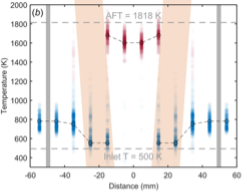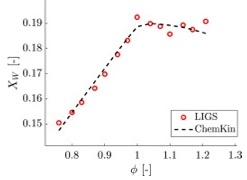LIGS
Laser Induced Grating Spectroscopy (LIGS) works by inducing a very small density perturbation using a high intensity laser pulse, and probing the region for the speed at which the perturbation travels, which equals the speed of sound. We use 1064 nm to to excite either air or water molecule line, and a 532 nm continuous probe laser to detect the change in index of refraciton in time. The advantages of the method are:
- very high precision which arises from the measurement of a frequency.
- easily available excitation line with high energies from Nd:YAG lasers
- works with sooty flows
- works well at high pressures
A disadvantage is relatively low resolution (mm) of the point measurements. Below are some recent advances using the optical technique.
| Figure | Reference |
|---|---|
 Temperatures measured across radial distance at 3 bar |
First demonstration of the use of LIGS for determining temperatures in a gas turbine combustor. Includes measurements of water vapour concentrations using the same technique. Spatial Temperature and Water Molar Concentration Measurements Using Thermal and Electrostrictive Laser-Induced Grating Spectroscopy During Operation of a Swirl Burner at Pressure (2024) L Weller, P Shah, A Giles, FD Domenico, S Morris, BAO Williams, J. Eng. Gas Turb. Power 146 (5), 051021. |
 Temperature vs equivalence ratio in a laminar flame |
In this paper, we develop the technique for temperature LITGS using water vapour, and electrostrictive LIGS (LIEGS) for zero water vapour concentrations. The ratio of the first to second peak intensity allows the water concentration to be determined. F. De Domenico, T. F. Guiberti, S. Hochgreb, W. L. Roberts,G. Magnotti, Temperature and water measurements in flames using 1064 nm Laser-Induced Grating Spectroscopy (LIGS), Combustion and Flame, 2019 |
 Temperature vs time |
These measurements demonstrated for the first time the use of burst mode lasers for high frequency LITGS measurements, in collaboration with KAUST. F. De Domenico, T. F. Guiberti, S. Hochgreb, W. L. Roberts,G. Magnotti, Tracer-free laser-induced grating spectroscopy using a pulse burst laser at 100 kHz, Optics Express, 2019 |
 Density perturbations vs time |
High frequency measurement of temperature and composition spots with LIGS. The work used LIGS for combined time-resolved temperature and concentration measurements in the duct using biacetyl as an absorber at 355 nm. F De Domenico, P Shah, SM Lowe, L Fan, P Ewart, BAO Williams, Journal of Engineering for Gas Turbines and Power (2019) 141 (3), 031003. |